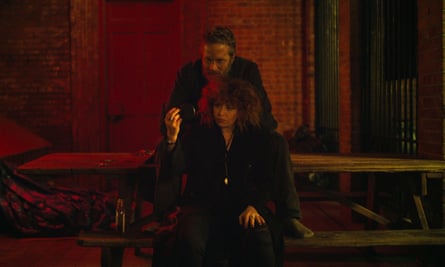By now, you have probably worked out that Netflix’s Russian Doll is much more than just an entertaining comedy-drama about a wise-cracking denizen of NYC’s East Village who keeps dying and coming back to life. The clues are there for the curious: co-creator and star Natasha Lyonne is a recovering addict whose real-life backstory overlaps with that of her character Nadia; many of the artists referenced in the show (musician Harry Nilsson, writer Lucy Maud Montgomery, film-maker Alejandro Jodorowsky) either themselves died of drug overdoses or were deeply affected by the death-by-overdoses of loved ones; one significant character is nicknamed Horse (a street name for heroin), and then there is the fact that everyone spends far too much time in the bathroom.
But spotting a few cool coincidences is not the same as fully appreciating a show as rich with meaning as Russian Doll. Are you ready to get some help with getting to the bottom of it? That’s Step One: admitting you’ve got a problem.
Anita Chellamah, a senior therapist with UK Addiction Treatment Centres and herself a recovering addict, says that on first watch she found the show kind of dull: “Initially I got really frustrated [with the repetition] and then as it progressed, I realised it was really reminding me of the monotony of active addiction, being back in the bathroom, the reliving everything, again and again and again.” She was also aware of how the show triggers an uncanny “am I tripping?” feeling of questioning your own perceptions: “It all feels so real, and yet is it?” she says. “The ‘same day, but also slightly different’ thing really reminded me of that kind of paranoia.”
It was, however, the repeated-death motif that resonated most: “I think it’s an emotional death. Because every time you’re using you’re killing your emotional connection to life. You can’t nurture yourself, you can’t nurture relationships. Addicts replace that with the substance; that becomes their intense love affair.”
Leslye Headland, co-creator and showrunner, says she has had her own experiences with addiction and treatment. “I am familiar with both 12-step recovery as well as CBT [cognitive behavioural therapy] and EMDR therapy [eye-movement desensitisation and reprocessing]”. The latter is briefly depicted in Russian Doll, being practised by Nadia’s therapist godmother Ruth during a session with a client. Headland confirms that the patterns of addiction are “laid into [the series’] foundation and the season arc”, but it’s more allegory than illustration.
Lyonne has used the intriguing phrase “quantum consequences” to describe exactly how the day-to-day toll of addiction manifests in Russian Doll. As the series continues past the first few episodes, it becomes apparent that while Nadia, and later Alan (Charlie Barnett), are repeatedly escaping death, their lives are deteriorating in other ways. Each time Nadia regenerates, there are fewer and fewer friends at her birthday party; items of furniture are gradually disappearing from Alan’s meticulously kept apartment; and oranges are rotting in the fruit bowls. “I have a friend who said, ‘Everybody gets a certain amount of chances with getting high in this life’,” Lyonne told Variety earlier this year. “Some people use them all up really quickly, and then they can continue to get high, but there will be consequences. So there are quantum consequences for each time they use up their allotted runs.” When speaking about her own experiences, however, Lyonne is inclined to be more literal: “I was definitely as good as dead, you know?” she told Entertainment Weekly. “A lot of people don’t come back. That makes me feel wary, and self-conscious. I wouldn’t want to feel prideful about it. People really rallied around me and pulled me up by my fucking bootstraps.”

Alcoholism and drug abuse are not a new subject for the screen, of course. Addiction stories such as The Lost Weekend (1945), Leaving Las Vegas (1995) and Requiem for a Dream (2000) have been showered with praise. TV shows on the subject include Netflix’s Flaked, based on the experiences of its star, Will Arnett, who also happens to be the ex-husband of Amy Poehler, the third of Russian Doll’s trio of co-creators.
Unlike all the above, however, Russian Doll is notable for not being a massive downer. The time-loop conceit allows the show to explore its themes without forcing viewers to confront the misery and degradation of serious addiction. It also makes space for Lyonne – long worshipped by 90s character-actor aficionados – to be her cynical, snarling, superstar best. Given that Lyonne’s early career promise was derailed for nearly a decade by heroin addiction this feels like a gloriously apt comeback.
Could Russian Doll itself be a useful therapeutic tool? It’s no aggressive intervention, but rather a nudge gentle enough to reach even those deep in denial. In this respect, the fact that it takes place on the night of Nadia’s 36th birthday party is significant. The mid-30s can be the 4am of life; a time when many decide to retire from the party, and the hedonistic behaviour of those left behind begins to take on a seedier aspect.
The main reason to be grateful for this show is that it pushes past addiction into what’s beyond. Other TV shows – The Sopranos, Nurse Jackie, Patrick Melrose, Californication, Fleabag – have powerfully depicted the struggles of addicts, but few do justice to what Chellamah calls “the Technicolor beauty of recovery”.
However, from the moment Nadia and Alan connect and become each other’s de facto AA sponsors, there is a light at the end of the tunnel to move towards. This odd couple – one extroverted and free spirited, the other uptight and timid – need each other, although it takes a while for them to work out why, exactly.
The idea that they are trapped inside some kind of computer game is mooted and theology is discussed, but like the 12-step programme itself, which refers to “God, as we understood Him”, Russian Doll doesn’t get too hung up on the divine. Eventually, Alan and Nadia park the theorising and together undertake the necessary work of self-inventory, acting as the each other’s therapist and anchor to reality.
Russian Doll’s finale allows viewers to vicariously experience that Technicolor beauty of recovery, without the tedium of addiction. More than that, by depicting the principles of treatment at one degree of allegorical remove, the show makes plain how much more widely applicable, for addicts and non-addicts alike, the 12 steps might be. Headland says she’s not at all bothered if this subtext passes most viewers by. “There are many layers. Many interpretations. And I support them all!” But the addiction allegory works well. Treatment literature is so full of metaphor and neat aphorisms, it lends itself naturally to an enjoyably Easter Egg-laden story structure such as this. If, as a famous line from a 1981 Narcotics Anonymous pamphlet had it: “The definition of insanity is doing the same thing over and over and expecting different results,” then repeat viewings of Russian Doll must be the one allowable exception. Box set bingeing isn’t exactly healthy, but clearly there are worse things to be addicted to.
Russian Doll is available to stream now on Netflix











Comments (…)
Sign in or create your Guardian account to join the discussion